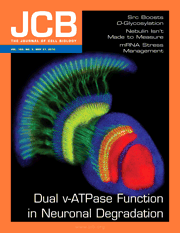A dual function of V0-ATPase a1 provides an endolysosomal degradation mechanism in Drosophila photoreceptors.
Williamson, W.R., Wang, D., Haberman, A.S. and Hiesinger, P.R. – 2010
The vesicular adenosine triphosphatase (v-ATPase) is a proton pump that acidifies intracellular compartments. In addition, mutations in components of the membrane-bound v-ATPase V0 sector cause acidification-independent defects in yeast, worm, fly, zebrafish, and mouse. In this study, we present a dual function for the neuron-specific V0 subunit a1 orthologue v100 in Drosophila melanogaster. A v100 mutant that selectively disrupts proton translocation rescues a previously characterized synaptic vesicle fusion defect and vesicle fusion with early endosomes. Correspondingly, V100 selectively interacts with syntaxins on the respective target membranes, and neither synaptic vesicles nor early endosomes require v100 for their acidification. In contrast, V100 is required for acidification once endosomes mature into degradative compartments. As a consequence of the complete loss of this neuronal degradation mechanism, photoreceptors undergo slow neurodegeneration, whereas selective rescue of the acidification-independent function accelerates cell death by increasing accumulations in degradation-incompetent compartments. We propose that V100 exerts a temporally integrated dual function that increases neuronal degradative capacity.



